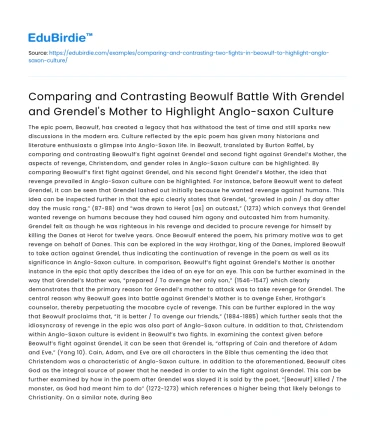The epic poem, Beowulf, has created a legacy that has withstood the test of time and still sparks new discussions in the modern era. Culture reflected by the epic poem has given many historians and literature enthusiasts a glimpse into Anglo-Saxon life. In Beowulf, translated by Burton Raffel, by comparing and contrasting Beowulf’s fight against Grendel and second fight against Grendel’s Mother, the aspects of revenge, Christendom, and gender roles in Anglo-Saxon culture can be highlighted.
By comparing Beowulf’s first fight against Grendel, and his second fight Grendel’s Mother, the idea that revenge prevailed in Anglo-Saxon culture can be highlighted. For instance, before Beowulf went to defeat Grendel, it can be seen that Grendel lashed out initially because he wanted revenge against humans. This idea can be inspected further in that the epic clearly states that Grendel, “growled in pain / as day after day the music rang,” (87-88) and “was drawn to Herot [as] an outcast,” (1273) which conveys that Grendel wanted revenge on humans because they had caused him agony and outcasted him from humanity. Grendel felt as though he was righteous in his revenge and decided to procure revenge for himself by killing the Danes at Herot for twelve years. Once Beowulf entered the poem, his primary motive was to get revenge on behalf of Danes. This can be explored in the way Hrothgar, king of the Danes, implored Beowulf to take action against Grendel, thus indicating the continuation of revenge in the poem as well as its significance in Anglo-Saxon culture.
Save your time!
We can take care of your essay
- Proper editing and formatting
- Free revision, title page, and bibliography
- Flexible prices and money-back guarantee
In comparison, Beowulf’s fight against Grendel’s Mother is another instance in the epic that aptly describes the idea of an eye for an eye. This can be further examined in the way that Grendel’s Mother was, “prepared / To avenge her only son,” (1546-1547) which clearly demonstrates that the primary reason for Grendel’s mother to attack was to take revenge for Grendel. The central reason why Beowulf goes into battle against Grendel’s Mother is to avenge Esher, Hrothgar’s counselor, thereby perpetuating the macabre cycle of revenge. This can be further explored in the way that Beowulf proclaims that, “it is better / To avenge our friends,” (1884-1885) which further seals that the idiosyncrasy of revenge in the epic was also part of Anglo-Saxon culture.
In addition to that, Christendom within Anglo-Saxon culture is evident in Beowulf’s two fights. In examining the context given before Beowulf’s fight against Grendel, it can be seen that Grendel is, “offspring of Cain and therefore of Adam and Eve,” (Yang 10). Cain, Adam, and Eve are all characters in the Bible thus cementing the idea that Christendom was a characteristic of Anglo-Saxon culture. In addition to the aforementioned, Beowulf cites God as the integral source of power that he needed in order to win the fight against Grendel. This can be further examined by how in the poem after Grendel was slayed it is said by the poet, “[Beowulf] killed / The monster, as God had meant him to do” (1272-1273) which references a higher being that likely belongs to Christianity.
On a similar note, during Beowulf’s fight against Grendel’s Mother, it can be observed that it was, “Holy / God who sent him victory” (1553-1554) during the fight. Another instance in which Chrisitendom appears is where Beowulf believes that he would have not come out victorious if, “[the] Father in Heaven had not helped [him]” (1659.) With the aforementioned in mind, it is almost needless to say that the aspect of Christendom in Anglo-Saxon culture can be highlighted by the fights in Beowulf.
The ideas of gender roles in Anglo-Saxon culture can be understood by contrasting Beowulf’s first fight against Grendel and his second fight against Grendel’s Mother. The idea of gender roles can be viewed primarily in the way that male characters, such as Grendel and Beowulf, have names while their female counterparts oftentimes do not. The prior statement reflects the idea that males were considered to be higher ranking because the presence of their names indicate their importance within the poem. In relation to the previous statement it can also be seen that, “ Beowulf and Grendel have the same power and are both awe inspiring.”(Yang 13) This goes on to support the idea that men were higher ranking individuals due to their surplus of strength. Thus, the idea of gender roles in Anglo-Saxon culture can be observed within the poem.
In contrast, Beowulf’s fight with Grendel’s Mother demonstrates the idea that women are subservient to men in regards to strength and courage. This can be seen in how there is no indication that Grendel’s Mother was given a name and how she was described prior to the fight with Beowulf. It can be observed that although she is fierce she did could not, “[Fight] with the power and courage as men could fight,” (1284.) Thus, by examining the difference in the depiction of the males and females of the poem, the contrasts in gender roles within Anglo-Saxon culture can be clearly seen.
Conclusion
The epic of Beowulf has painted an incredibly detailed account on Anglo-Saxon culture and its many varied facets. The fights hold deeper connotations than what one would initially expect from their first reading, but upon further inspection more introspective meanings can be derived. By exploring the similarities and differences between two of Beowulf’s fights, the Anglo-Saxon cultural ideas of revenge, Christendom, and gender roles can be clearly identified.
Works Cited
- Raffel, Burton tr. cn. Beowulf. A New Translation with an Introd. by Burton Raffel. Signet Classic, 1963.
- Yang, Chih-chiao Joseph. 'Humanizing the Monsters: A Schematic Reading of Beowulf.' Tamkang Review, vol. 44, no. 1, 2013, p. 3+. Gale In Context: World History, https://link.gale.com/apps/doc/A361241911/WHIC?u=j101907007&sid=WHIC&xid=c5afee03. Accessed 19 Sept. 2019.






 Stuck on your essay?
Stuck on your essay?

